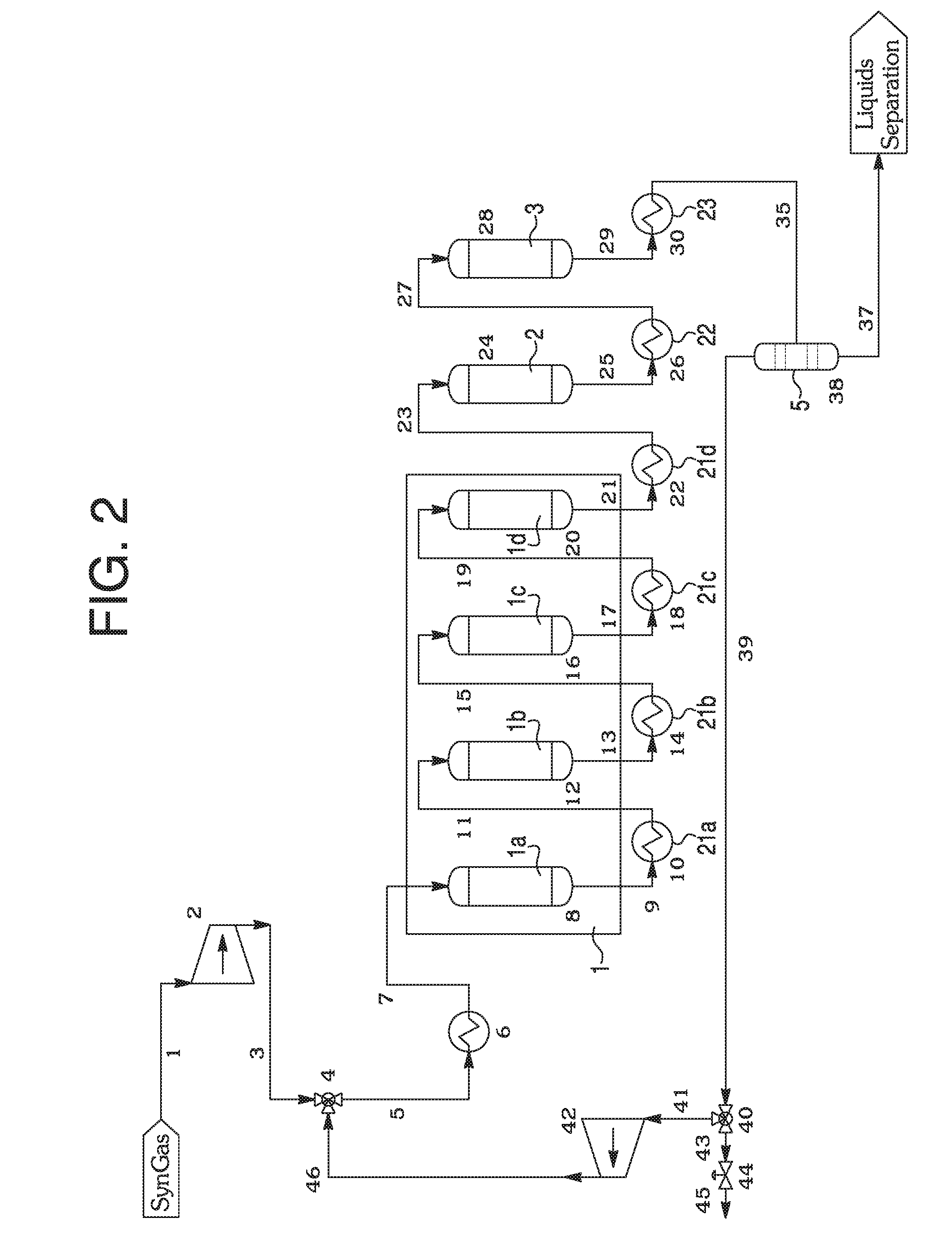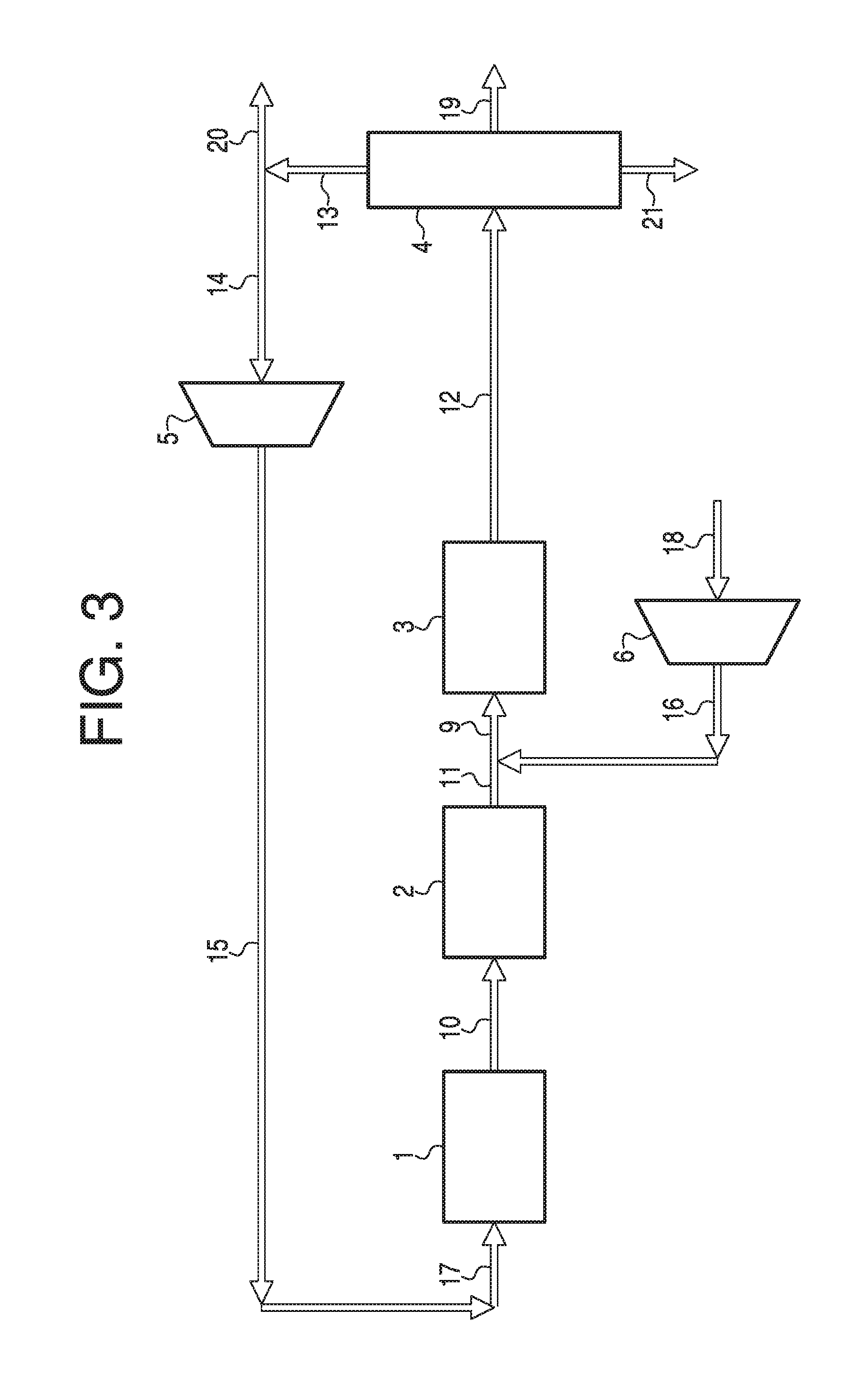Novel configuration in single-loop synfuel generation
a single-loop, synfuel technology, applied in the direction of ether preparation, ether preparation, hydrocarbon oil treatment products, etc., can solve the problems of high undesirable tetra-methylbenzene and durene production, skew the distribution of synfuel compounds, and the viscometric behavior cannot be tolerated in an all-weather commercial fuel, so as to enhance the conversion of synthesis gas, and improve the viscometric properties
- Summary
- Abstract
- Description
- Claims
- Application Information
AI Technical Summary
Benefits of technology
Problems solved by technology
Method used
Image
Examples
example 1
[0042]In the foregoing and other contemplated embodiments of the invention disclosed, the merging of the hydrocarbon synthesis and hydrotreatment reactions into a single combined process is the seminal accomplishment. This inventive leap required extensive research to determine how to accommodate presence of undesired carbon monoxide in the hydrotreatment phase of the process. The major function for the hydrotreating catalyst, zeolite, is to reduce durene and other heavy gasoline components through disproportionation, isomerization and transalkylation. All of these processes require hydrogenation of the target molecules and proper positioning of adjacent reactive molecules. Under normal hydrogenation, all methyl-substituted aromatics follow a general trend of tetramethylbenzenes<trimethylbenzenes<xylenes<toluene, where the lower methyl-substituted aromatics exhibit easier hydrogenation capability than the higher methyl-substituted aromatics. However, in the presence of carbon monoxi...
example 2
[0047]A set of microreactor experiment was conducted to evaluate the right combination for gasoline synthesis and hydrotreatment catalysts. The microreactor setup is similar to the one in Example 1 containing two reactors in series. A fixed amount of methanol was directly injected into the first reactor containing γ-alumina so that a conversion of methanol into dimethylether could be achieved. The product from the first reactor was then fed into the second reactor containing two different zeolite catalysts for gasoline generation and transalkylation. These two catalysts could be separated as two layers or mixed as one single phase. The first catalyst (catalyst A) was a typical hydrocarbon generation catalyst such as ZSM-5. The second catalyst (catalyst B) was a larger pore size zeolite sample which would carry transalkylation function of the product from catalyst A with diffusivity benefit (allowing reactants and products to diffuse in and out of the pore easily with short space tim...
example 3
[0052]In example 2, we have demonstrated the difference between the following two cases, (catalyst A) vs. (catalyst A+catalyst B). It demonstrates that the use of two catalysts in series shows a higher yield of the preferred end-products. In this experiment catalyst A is H:ZSM-5, while catalyst B is Y-zeolite. After the verification of the transalkylation function of R4, we need to evaluate the synergy for a combination of ZSM-5 catalyst and Y-zeolite catalyst in MTG chemistry. When catalyst B is mixed with catalyst A, certain intermediates generated during transalkylation process can react or participate with hydrocarbon synthesis mechanism from methanol or DME and promote the hydrocarbon formation reaction. The gas phase products of a reaction catalyzed by A (ZSM-5) and the combination case of (catalyst A+catalyst B) can be easily monitored by GC.
[0053]In this example, a single reactor, which merges the hydrocarbon synthesis and hydrotreatment steps, is examined. The present inven...
PUM
| Property | Measurement | Unit |
|---|---|---|
| freezing point | aaaaa | aaaaa |
| pressure | aaaaa | aaaaa |
| melting points | aaaaa | aaaaa |
Abstract
Description
Claims
Application Information
 Login to View More
Login to View More - R&D
- Intellectual Property
- Life Sciences
- Materials
- Tech Scout
- Unparalleled Data Quality
- Higher Quality Content
- 60% Fewer Hallucinations
Browse by: Latest US Patents, China's latest patents, Technical Efficacy Thesaurus, Application Domain, Technology Topic, Popular Technical Reports.
© 2025 PatSnap. All rights reserved.Legal|Privacy policy|Modern Slavery Act Transparency Statement|Sitemap|About US| Contact US: help@patsnap.com



